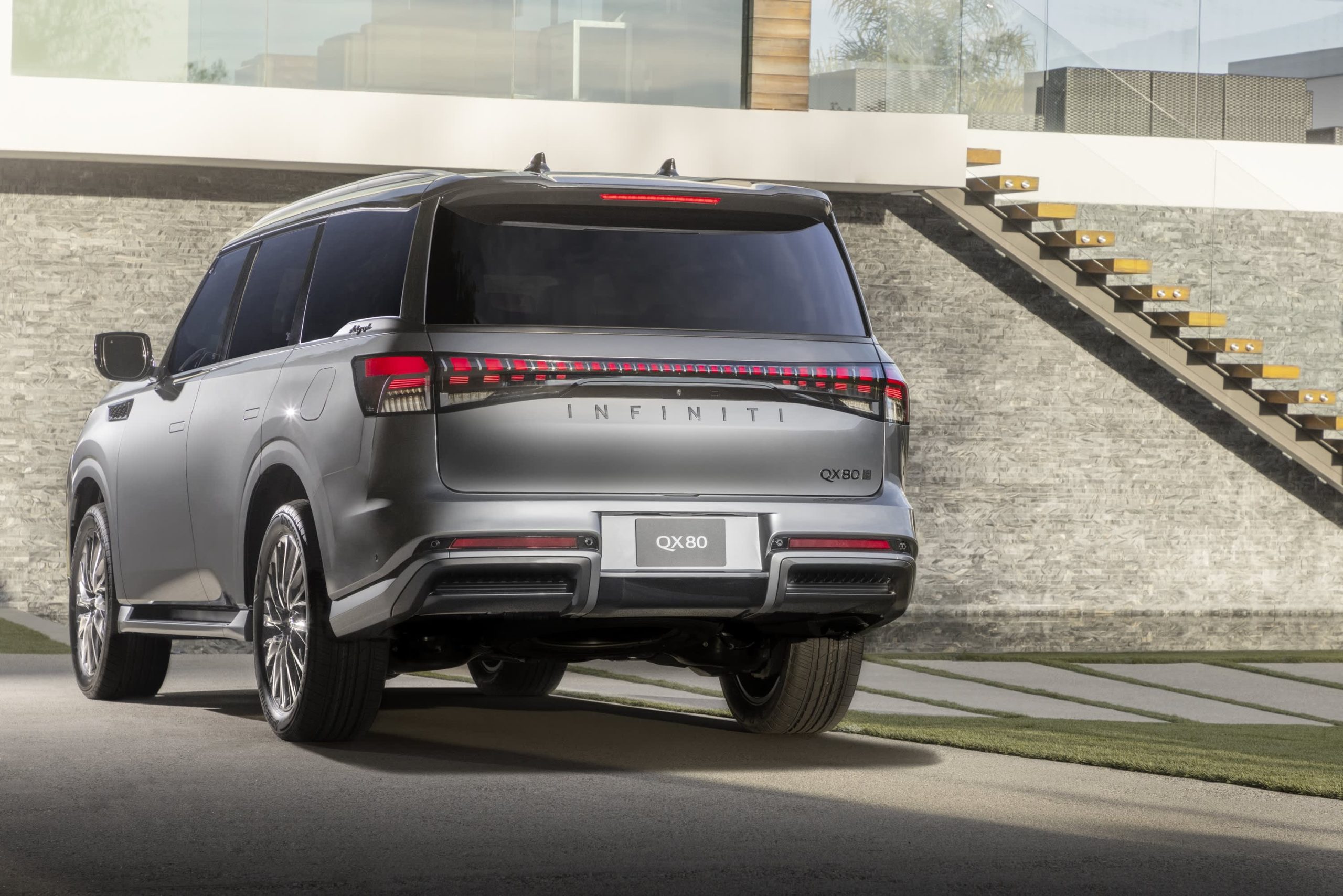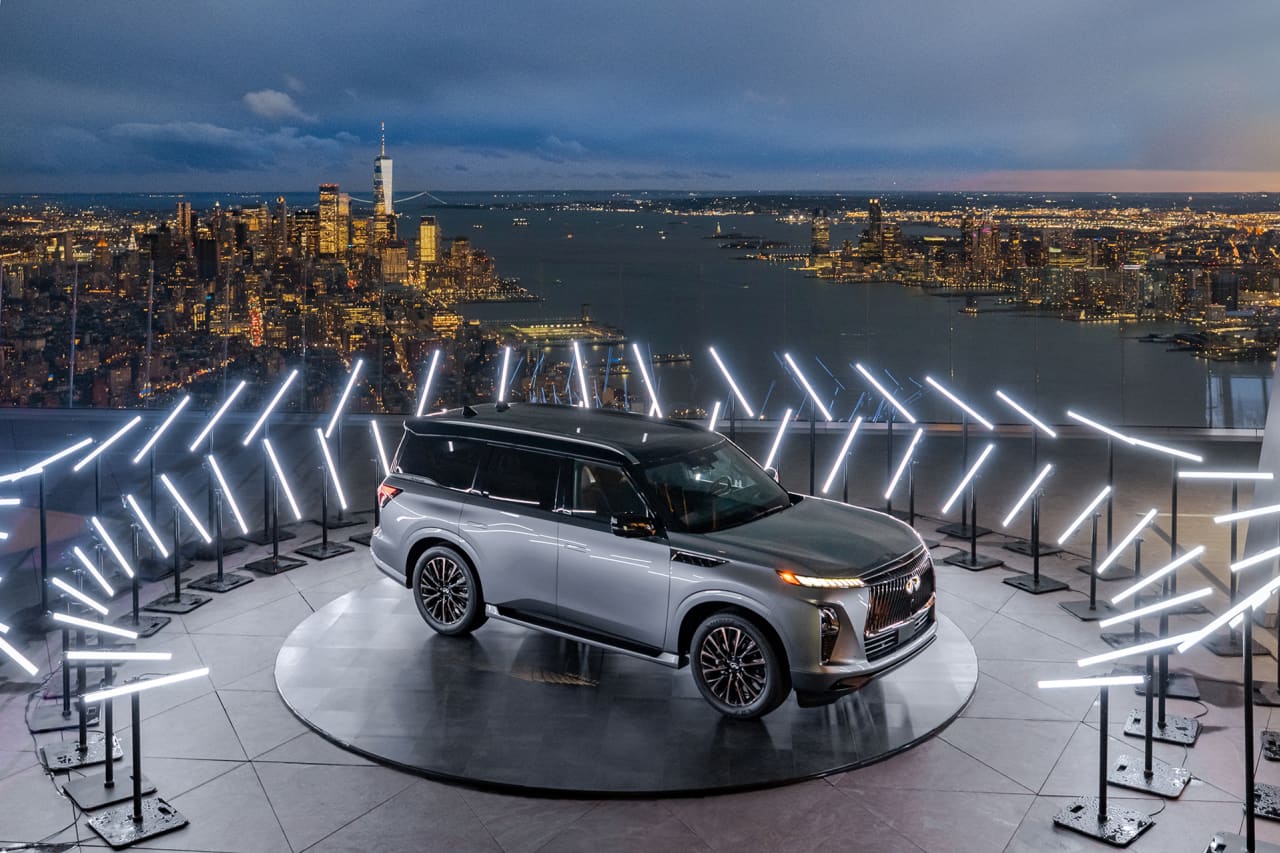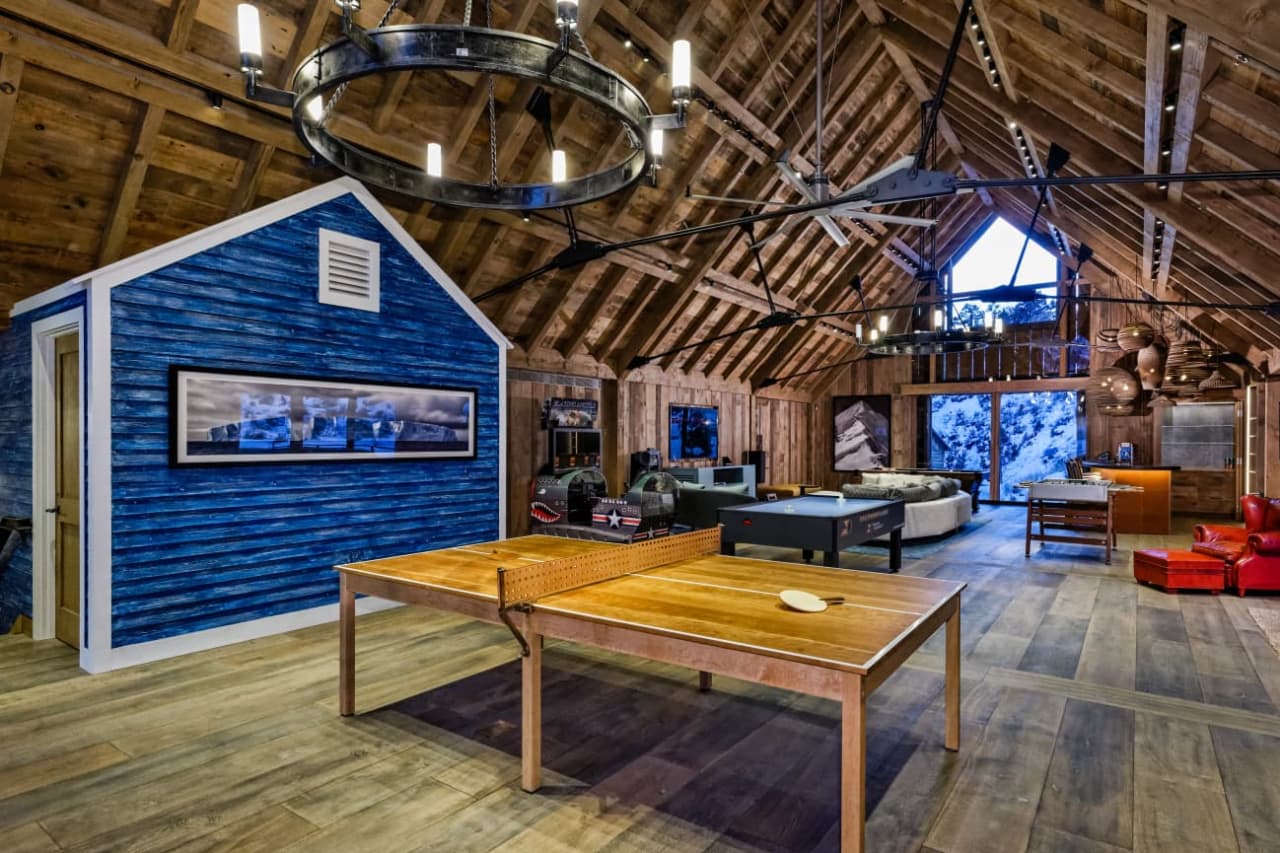The Three-Row 2025 Infiniti QX80 Makes a Sky-High Debut in New York
The 2025 Infiniti QX80, which will go on sale towards the end of summer, made a high-flying global debut in Manhattan last month.
The huge, three-row SUV was cut up into pieces then transported via elevator to the 100th floor observation deck of the Edge at Hudson Yards. The Infiniti, the first car to be so ensconced, was revealed 1,100 feet up amid flashing colour lights in partnership with iHeartMedia in a live stream as night descended on New York City. Later, five-time Grammy winner singer/pianist Jon Batiste entertained a group that included executives and dealers.
Luxury three-row SUVs have turned into an important segment, including electric entries such as the seven-passenger Kia EV9 and Cadillacs Escalade IQ and Vistiq (coming as a 2026 model). The QX80 isn’t electric; it’s powered by a 3.5-litre twin-turbo V6-rated engine with 450 horsepower and 516 pound-feet of torque. That’s up 50 horsepower and 103 pound-feet from the current QX80. The nine-speed automatic transmission is shifted with piano key buttons.
Prices start at US$82,450 for the Pure rear-wheel drive version, and soar to US$110,595 for the Autograph all-wheel drive (with four iterations in between). At the launch, Craig Keeys, group vice president of Infiniti Americas, described the QX80 as “our new flagship, pushing the envelope from ordinary to extraordinary.” Keeys didn’t mention the twin-turbo V6 power, and the other speakers skipped over it too—the QX80 is all about luxurious refinements and tech innovations.

Infiniti
For instance, heated and cooled seats for the first two rows are available, as is massaging in the second row. Upscale Autograph buyers get rear climate controls via touchscreen. Much mentioned at the launch was the segment-first availability of biometric cooling, which monitors second-row passengers body temperatures and automatically adjusts the climate controls and air flow to that section. So, if mom picks up an overheated soccer player, he or she will be cooled down while other passengers and the driver stay steady.
And then there’s the top of the line 1,200-watt, 44-speaker Klipsch premiere audio system with a 24-channel amplifier and, among other things, titanium tweeters and speakers in the roof. Other carmakers have big stereos, too, but this one has something called Individual Audio, which directs phone calls and navigation to the front headrest speakers without interrupting the cabin’s music. Or the driver can listen to sounds directed only at him or her, without waking up sleeping passengers.
The interior on the QX80 is decidedly upscale, with leather, wood, suede, and metal elements. There are two 14.3-inch displays. The driver’s screen has three separate views, and there is a nine-inch touchscreen below the infotainment display with climate functions and a haptic element to let users feel when their fingers are on the correct virtual button. A colour head-up display is available. When drivers approach their QX80, its flush door handles open up to welcome them.

Infiniti
At the top of the line is the Autograph grade, which gets a two-tone roof, dark chrome trim, and unique 22-inch Turbine wheels. Inside, it benefits from semi-aniline leather with hand stitching and open-pore ash wood trim with aluminium accents.
As it sat under the coloured lights on the vertigo-inducing observation deck, with a cold wind blowing, it was possible only to get a quick first impression of the QX80. It’s big, the type of SUV that only American automakers built until the Asian brands realised it’s a highly lucrative market. And recent experience suggests that buyers want their three-row SUVs with the top infotainment and luxury appointments. Hence the Autograph version might do quite well.
Batiste, with a drummer and alto sax player, played four songs, mixing up jazz, funk, New Orleans percussion interludes, and soul. He was kinetic, barely staying at the piano for half a song. One number combined John Coltrane and the Beatles before it turned to some jazz-rock. The children’s song “If You’re Happy and You Know It” became a bravura version of “When the Saints go Marching In.” In a brief interview, Batiste was asked about seeing the QX80 on that windswept platform. “It proves it’s durable,” Batiste says.
 Copyright 2020, Dow Jones & Company, Inc. All Rights Reserved Worldwide. LEARN MORE
Copyright 2020, Dow Jones & Company, Inc. All Rights Reserved Worldwide. LEARN MORE
This stylish family home combines a classic palette and finishes with a flexible floorplan
Just 55 minutes from Sydney, make this your creative getaway located in the majestic Hawkesbury region.
As Paris makes its final preparations for the Olympic games, its residents are busy with their own—packing their suitcases, confirming their reservations, and getting out of town.
Worried about the hordes of crowds and overall chaos the Olympics could bring, Parisians are fleeing the city in droves and inundating resort cities around the country. Hotels and holiday rentals in some of France’s most popular vacation destinations—from the French Riviera in the south to the beaches of Normandy in the north—say they are expecting massive crowds this year in advance of the Olympics. The games will run from July 26-Aug. 1.
“It’s already a major holiday season for us, and beyond that, we have the Olympics,” says Stéphane Personeni, general manager of the Lily of the Valley hotel in Saint Tropez. “People began booking early this year.”
Personeni’s hotel typically has no issues filling its rooms each summer—by May of each year, the luxury hotel typically finds itself completely booked out for the months of July and August. But this year, the 53-room hotel began filling up for summer reservations in February.
“We told our regular guests that everything—hotels, apartments, villas—are going to be hard to find this summer,” Personeni says. His neighbours around Saint Tropez say they’re similarly booked up.
As of March, the online marketplace Gens de Confiance (“Trusted People”), saw a 50% increase in reservations from Parisians seeking vacation rentals outside the capital during the Olympics.
Already, August is a popular vacation time for the French. With a minimum of five weeks of vacation mandated by law, many decide to take the entire month off, renting out villas in beachside destinations for longer periods.
But beyond the typical August travel, the Olympics are having a real impact, says Bertille Marchal, a spokesperson for Gens de Confiance.
“We’ve seen nearly three times more reservations for the dates of the Olympics than the following two weeks,” Marchal says. “The increase is definitely linked to the Olympic Games.”

Getty Images
According to the site, the most sought-out vacation destinations are Morbihan and Loire-Atlantique, a seaside region in the northwest; le Var, a coastal area within the southeast of France along the Côte d’Azur; and the island of Corsica in the Mediterranean.
Meanwhile, the Olympics haven’t necessarily been a boon to foreign tourism in the country. Many tourists who might have otherwise come to France are avoiding it this year in favour of other European capitals. In Paris, demand for stays at high-end hotels has collapsed, with bookings down 50% in July compared to last year, according to UMIH Prestige, which represents hotels charging at least €800 ($865) a night for rooms.
Earlier this year, high-end restaurants and concierges said the Olympics might even be an opportunity to score a hard-get-seat at the city’s fine dining.
In the Occitanie region in southwest France, the overall number of reservations this summer hasn’t changed much from last year, says Vincent Gare, president of the regional tourism committee there.
“But looking further at the numbers, we do see an increase in the clientele coming from the Paris region,” Gare told Le Figaro, noting that the increase in reservations has fallen directly on the dates of the Olympic games.
Michel Barré, a retiree living in Paris’s Le Marais neighbourhood, is one of those opting for the beach rather than the opening ceremony. In January, he booked a stay in Normandy for two weeks.
“Even though it’s a major European capital, Paris is still a small city—it’s a massive effort to host all of these events,” Barré says. “The Olympics are going to be a mess.”
More than anything, he just wants some calm after an event-filled summer in Paris, which just before the Olympics experienced the drama of a snap election called by Macron.
“It’s been a hectic summer here,” he says.

AFP via Getty Images
Parisians—Barré included—feel that the city, by over-catering to its tourists, is driving out many residents.
Parts of the Seine—usually one of the most popular summertime hangout spots —have been closed off for weeks as the city installs bleachers and Olympics signage. In certain neighbourhoods, residents will need to scan a QR code with police to access their own apartments. And from the Olympics to Sept. 8, Paris is nearly doubling the price of transit tickets from €2.15 to €4 per ride.
The city’s clear willingness to capitalise on its tourists has motivated some residents to do the same. In March, the number of active Airbnb listings in Paris reached an all-time high as hosts rushed to list their apartments. Listings grew 40% from the same time last year, according to the company.
With their regular clients taking off, Parisian restaurants and merchants are complaining that business is down.
“Are there any Parisians left in Paris?” Alaine Fontaine, president of the restaurant industry association, told the radio station Franceinfo on Sunday. “For the last three weeks, there haven’t been any here.”
Still, for all the talk of those leaving, there are plenty who have decided to stick around.
Jay Swanson, an American expat and YouTuber, can’t imagine leaving during the Olympics—he secured his tickets to see ping pong and volleyball last year. He’s also less concerned about the crowds and road closures than others, having just put together a series of videos explaining how to navigate Paris during the games.
“It’s been 100 years since the Games came to Paris; when else will we get a chance to host the world like this?” Swanson says. “So many Parisians are leaving and tourism is down, so not only will it be quiet but the only people left will be here for a party.”
This stylish family home combines a classic palette and finishes with a flexible floorplan
Just 55 minutes from Sydney, make this your creative getaway located in the majestic Hawkesbury region.






















